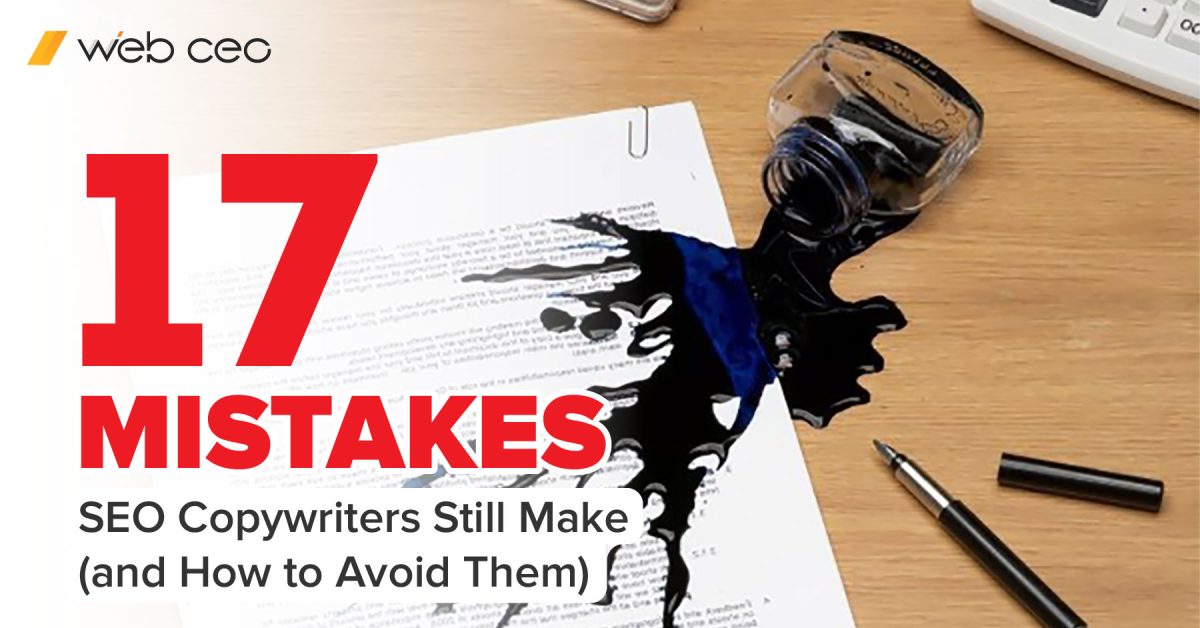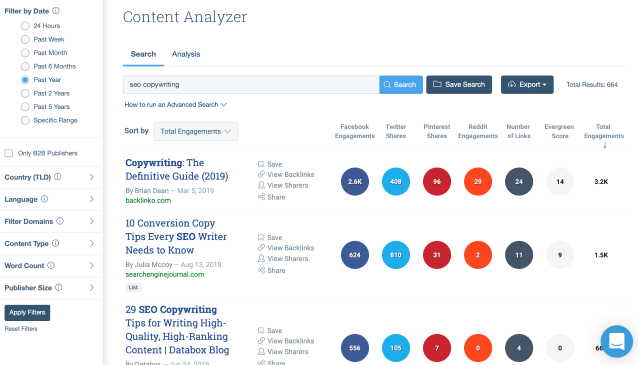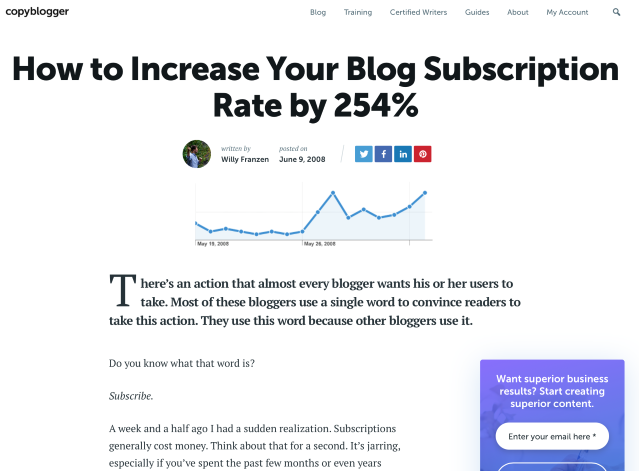
Believe it or not, some SEO copywriters still write copy like it’s 2009!
Big mistake!
You’ve got to adapt your copywriting style to meet all the changes happening in the SEO realm.
That sounds uncomfortable. However, if you’re serious about becoming a copywriter, you will have to get rid of mistakes you’re probably making. Counter them with these helpful SEO copywriting tips.
SEO copywriting mistake #1: Not customizing your strategy
Your clients come from different industries and have a specific type of customer they want to target. More importantly, each has its own culture that influences how they communicate with their prospects and customers.
Solution:
Don’t let your copy stick out like a sore thumb. Not only will it be evident that someone else wrote it, but also cause readers to question your client’s credibility.
Go through your client’s published content. Look for a specific copywriting technique or model they use when writing them, and use this as a guide when you write your copy.
SEO copywriting mistake #2: Not doing your research
If you want your copy to effectively attract and convert your client’s prospects, you must know as much about them as possible.
And because 93% of people begin their search for a product or service on Google (or another search engine), you must also know what keywords they use when they do a search query.
Solution:
Find out who your client’s competitors are and review their copy. Take note of what they highlight about their products or services.
Investing in an excellent keyword planning tool will also come in handy. It’ll quickly show you what keywords your readers use when searching on Google so you can use these in your copy.
SEO copywriting mistake #3: Going overboard with keywords
The right keywords will get your copy in front of your target readers. However, stuffing your text with keywords like a turkey on Thanksgiving or using black-hat and grey-hat SEO techniques is going to cause Google to slap you with a penalty.
Solution:
Target people, not machines. When you write your copy, imagine you’re sharing to a friend about a fantastic product or service you’ve found. This will help stop you from going overboard with your keywords.
SEO copywriting mistake #4: Ignoring of a user’s intent
Understanding and implementing of a user’s intent is crucial for successful SEO copywriting.
Many writers focus on incorporating specific keywords into their content, inadvertently overlooking the fundamental purpose behind user searches.
Solution: Take the time to research and analyze the primary intent behind the keywords you plan to include in your content. Put yourself in the shoes of your target audience and ask yourself: “What information or solution are they seeking with this search?”
Tailor your copy to directly address these user queries, providing valuable and relevant content that fulfills their needs. By aligning your writing with user intent, you enhance your SEO and build trust and authority with your audience.
SEO copywriting mistake #5: Using writing tools like a crutch
Writing tools like Grammarly and Hemingway are extremely helpful in catching embarrassing spelling and grammar mistakes. They can even find phrases that might cause your text to be flagged for plagiarism so that you can rewrite them before publishing.
But they’re not perfect. Now and then, they’ll miss a word that’s misused or misplaced. Other times, they’ll fix your sentences so that they’re grammatically correct, but sound weird when you read them.
Solution:
Read your copy out loud while you’re proofreading it. This will help you fix errors that these tools may have overlooked. You’ll also see whether or not the edits will make your copy easier to read and understand. In addition to this, using a tool like the SEO Content Assistant from WebCEO can further refine your content, ensuring it’s not only grammatically correct but also optimized for search engines.
SEO copywriting mistake #6: Not linking to reliable sources
Millions of blog posts get published daily. So the niche or topic you’re writing about may already be saturated with content.
People are now more skeptical about what they read online. They no longer take in any content at face value. Failing to support your copy by linking it to credible sources means that you’re missing out an excellent opportunity to increase your copy’s ranking on Google.
When you have reliable sources to back up your claims, your readers are more likely to take the time to read and digest your copy. Google will take note of this, and will reward your copy with a higher ranking.
Solution:
Make sure that you back up statements by linking them to what Google will consider credible and reliable online sources. Buzzsumo is a great tool to help you find these.
Screenshot from Buzzsumo
SEO copywriting mistake #7: Not adding internal links
Conversely, some copywriters do an excellent job linking parts of their copy to outside sources, but completely forget to add internal links aka links that go to other content published by your client.
There are two reasons to include internal links to your copy.
First, it feeds your readers with more valuable information. That means they don’t only stay on your client’s website longer, but these links help cement your client’s credibility and authority with them.
Second, it makes it easier for search bots to find relevant content they can index and include in their SERPs.
Solution:
Check your client’s website for previously published content that will support what you have written in your copy.
Also, make sure that you link relevant web pages. For example, if you’re writing to promote your client’s products, you can link their product pages to your copy.
SEO copywriting mistake #8: Sounding too “salesy”
The reason why content is now the king of the online marketing universe is that people don’t want to be sold to. So if your copy sounds like an infomercial script, you’re giving your readers a perfect reason to ignore it.
Solution:
Understand that people who find your copy are those looking for a solution to their problems.
Your job as an SEO copywriter is to feed them this through your copy. Only when you’ve satisfied readers that you can solve their problems, should you then begin talking about the features of the product or service you’re promoting.
Also, go easy on the adjectives. Having too many adjectives before a noun screams “SALES PITCH!” to your readers.
SEO copywriting mistake #9: Being too wordy
A predominant characteristic exhibited by novice wordsmiths is the exuberant use of intricate verbiage and statements to convey to those that peruse what they have inscribed despite the fact that such statements could otherwise be transmitted in a manner that is unpretentious and terms that are uncomplicated to comprehend.
Translation: A common habit among amateur writers is using too many complicated words and sentences when they write, when simple and easy to understand phrases would have sufficed.
The first sentence might make you sound smart. But using big, fancy words in your copy makes it difficult for your readers to understand what the heck you’re saying. They won’t even bother trying. They’ll just hit the back button and check out.
Solution:
According to a Neilsen Norman Group study, copy that’s easily understood by 8thgraders works best.
When writing your copy, use simple words and short sentences. The simpler, the better.
Get a friend or someone you trust to read your copy. If there are some parts in your text that are confusing them, simplify these areas further.
SEO copywriting mistake #10: Overusing ChatGPT in articles
When writers heavily depend on ChatGPT to generate most of their content, it can result in articles that sound generic and fail to resonate with the audience on a personal level.
The content may lack the human touch and emotional connection that is essential for engaging readers.
Solution:
Use ChatGPT as a supplementary tool, not a replacement for your creativity. While ChatGPT is a valuable asset that can help with brainstorming ideas, generating outlines, and providing relevant information, it’s crucial to maintain your unique perspective and writing style.
After using ChatGPT to assist with content creation, take the time to review and revise the text, infusing it with your personal touch and expertise.
As Google says, if your content is useful, helpful, original, and satisfies aspects of Expertise, Experience, Authority, and Trust, it might do well in Search, even though you used AI.
By striking the right balance between AI assistance and human creativity, you can create informative and well-structured articles that carry your distinctive voice.
SEO copywriting mistake #11: Not including a Call-to-Action (CTA).
This is a mortal sin, and yet lots of SEO copywriters still make this mistake.
What makes copywriting different from all other forms of online writing is its ability to convince people to take the desired action. If there’s no CTA in your copy, how on earth will your readers know what to do next?
No CTA also means no conversions for your client, which is the numero uno reason why they hired you.
Solution:
Make it a point to always include a CTA in your copy!
Moreover, make sure it tells your readers what they should do next. This should be based on the goal that your client wants to achieve.
For example, if your client’s goal is to get more qualified leads, a good CTA would be to get the readers to schedule a demo or get a free trial.
SEO copywriting mistake #12: Making titles an after-thought.
NEWSFLASH: Your copy’s title is as important—if not more important—than the text you’ve written, and even more critical than your CTA.
Why?
Because the only thing that people will see is your copy’s title in SERPs. If your title doesn’t grab their attention, nothing else matters.
Solution:
Give as much care and attention as possible to your copy’s title so that it piques your reader’s interest.
Some ways you can do this include:
- Adding numbers,
- Directly saying what problem you’re solving, and
- Whetting their curiosity.
Take this title from one of Copyblogger’s most successful posts as an example:
It blends all the three suggestions I mentioned. It includes a specific number. It tells what problem reading this blog post will solve (getting more subscribers). They made people curious about how they did it.
SEO copywriting mistake #13: Confusing opinions for facts
Many SEO copywriters (especially those starting out), will take information their clients give them to use in their copy as facts. They don’t bother to verify these details.
The problem here’s that if you don’t take the time to check the data you present in your copy, your readers will. If they find that the data presented isn’t accurate, they’ll become apprehensive about doing business with your client.
This will also damage your reputation as an SEO copywriter. It’ll be reason enough for your clients to end their contract with you, and more difficult to get new ones.
Solution:
Always do your research to verify that the details you’ve been given to use in your copy are accurate. If they’re not, make it a point to explain to your client why you can’t use them in your text.
SEO copywriting mistake #14: Quantity over quality
Several studies have encouraged copywriters to write long-form content because they do a better job of increasing page rankings.
As a result, some SEO copywriters have resorted to writing as much as they can so they can meet the “ideal” word count.
Solution:
If your final copy is only 800 words, but it’s packed with valuable info, then keep it at that. It’ll be more effective in converting your readers than a 2,000+ word text full of rambling and useless information.
SEO copywriting mistake #15: Thin content
Thin content doesn’t just mean writing short blog posts and articles with very little value. As Matt Cutts of Google explains in this video, there are several other types, such as:
- Doorway pages
- Thin affiliates
- Plagiarized content
All of them will prompt Google to take action against your site.
Solution:
As Matt Cutts said in the video, make sure you make it a top priority to provide quality to your readers when writing your copy.
Additionally, check your client’s website for similar content you can build upon rather than starting from scratch. That way, you increase that content’s value. You’ll also prevent Google from penalizing your copy as a duplicate content.
SEO copywriting mistake #16: Ignoring Brand Tone of Voice
The brand’s tone of voice encompasses its core values, philosophy, and attitude toward its audience.
It plays a pivotal role in determining the choice of words and sentence structure used in copies to communicate the brand’s message effectively.
Solution:
When working on copy for a client, it is imperative to either have access to the brand’s style guide or meticulously study their previously published content.
By embracing the brand’s tone of voice, you establish a genuine connection with the target audience, enhancing brand recognition and loyalty. Your words can be a powerful tool to evoke emotions, foster trust, and inspire action, ultimately bolstering the brand’s identity and market presence.
SEO copywriting mistake #17: Writing like a robot.
Your readers are emotional buyers, and they want to connect with your client’s business on a personal level. Bombarding them with facts using ultra-formal language in your copy isn’t going to help.
Solution:
Writing how you would talk to a friend asking for advice and telling stories… this is an effective way to humanize your copy.
Just make sure that your tone and choice of words match what your client uses. For example, if your client’s content doesn’t include slang, it’s best not to include these words in your copy even if that’s how you speak.
SEO copywriters are human and prone to making mistakes. Remembering who your target readers are, what they want to know, and how they’d like to be approached will help you lessen the chances of making blunders. To be on the safe side, be sure to check your articles for SEO mistakes – your rankings will be grateful.






